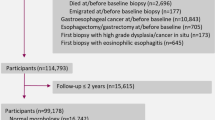Abstract
Background/Aim
Barrett’s esophagus (BE) is a precursor of esophageal adenocarcinoma (EAC). Therefore, an accurate diagnosis of BE is important for the subsequent follow-up and early detection of EAC. However, the definitions of BE have not been standardized worldwide; columnar-lined epithelium (CLE) without intestinal metaplasia (IM) and/or < 1 cm is not diagnosed as BE in most countries. This study aimed to clarify the malignant potential of CLE without IM and/or < 1 cm genetically.
Method
A total of 96 consecutive patients (including nine patients with EAC) who had CLE were examined. Biopsies for CLE were conducted, and patients were divided into those with IM and > 1 cm (Group A) and those without IM and/or < 1 cm (Group B). Malignant potential was assessed using immunochemical staining for p53. Moreover, causative genes were examined using next-generation sequencing (NGS) on ten patients without Helicobacter pylori infection and without atrophic gastritis.
Result
Of the 96 patients, 66 were in Group B. The proportion of carcinoma/dysplasia in Group A was significantly higher than that in Group B (26.7% in Group A and 1.5% in Group B; p < 0.01). However, one EAC patient was found in Group B. In the immunostaining study for non-EAC patients, an abnormal expression of p53 was not observed in Group A, whereas p53 loss was observed in three patients (4.6%) in Group B. In the NGS study, a TP53 mutation was found in Group B.
Conclusion
CLE without IM and/or < 1 cm has malignant potential. This result suggests that patients with CLE as well as BE need follow-up.


Similar content being viewed by others
Abbreviations
- BE:
-
Barrett’s esophagus
- CLE:
-
Columnar-lined epithelium
- EAC:
-
Esophageal adenocarcinoma
- IM:
-
Intestinal metaplasia
- SCJ:
-
Squamocolumnar junction
- PVs:
-
Palisade vessels
- LSBE:
-
Long-segment Barrett’s esophagus
- SSBE:
-
Short-segment Barrett’s esophagus
- USSBE:
-
Ultrashort segment Barrett’s esophagus
- NGS:
-
Next-generation sequencing
- SD:
-
Standard deviation
- ESCC:
-
Esophageal squamous cell carcinoma
References
Spechler SJ, Goyal RK. Barrett’s esophagus. N Engl J Med. 1986;315:362–371.
Barrett NR. The lower esophagus lined by columnar epithelium. Surgery. 1957;41:881–894.
Pohl H, Welch HG. The role of overdiagnosis and reclassification in the marked increase of esophageal adenocarcinoma incidence. J Natl Cancer Inst. 2005;97:142–146.
Everhart JE, Ruhl CE. Burden of digestive diseases in the United States part I: overall and upper gastrointestinal diseases. Gastroenterology. 2009;136:376–386.
Caygill CP, Royston C, Charlett A, et al. Mortality in Barrett’s esophagus: three decades of experience at a single center. Endoscopy. 2012;44:892–898.
Shaheen NJ, Falk GW, Iyer PG, et al. American College of Gastroenterology. ACG Clinical Guideline: Diagnosis and Management of Barrett’s Esophagus. Am J Gastroenterol. 2016;111:30–50.
Japan Esophageal Society. Japanese Classification of Esophageal Cancer, 11th Edition. Esophagus. 2017; 14: 37–65.
Bhat S, Coleman HG, Yousef F, et al. Risk of malignant progression in Barrett’s esophagus patients: results from a large population-based study. J Natl Cancer Inst. 2011;103:1049–1057.
Younes M, Brown K, Lauwers GY, et al. p53 protein accumulation predicts malignant progression in Barrett’s metaplasia: a prospective study of 275 patients. Histopathology. 2017;71:27–33.
Younes M, Ertan A, Lechago LV, et al. P53 Protein accumulation is a specific marker of malignant potential in Barrett’s metaplasia. Dig Dis Sci. 1997;42:697–701. https://doi.org/10.1023/A:1018828207371.
Contino G, Vaughan TL, Whiteman D, et al. The evolving genomic landscape of Barrett’s esophagus and esophageal adenocarcinoma. Gastroenterology. 2017;153:657–673.
Stachler MD, Camarda ND, Deitrick C, et al. Detection of mutations in Barrett’s esophagus before progression to high-grade dysplasia or adenocarcinoma. Gastroenterology. 2018;155:156–167.
Amano Y, Ishimura N, Furuta K, et al. Which landmark results in a more consistent diagnosis of Barrett’s esophagus, the gastric folds or the palisade vessels? Gastrointest Endosc. 2006;64:206–211.
Dixon MF, Genta RM, Yardley JH, Correa P. Classification and grading of gastritis. The Updated Sydney System. International Workshop on the Histopathology of Gastritis, Houston 1994. Am J Pathol. 1996;20:1161–1181.
Timmer MR, Martinez P, Lau CT, et al. Derivation of genetic biomarkers for cancer risk stratification in Barrett’s oesophagus: a prospective cohort study. Gut. 2016;65:1602–1610.
Thota PN, Vennalaganti P, Vennelaganti S, et al. Low risk of high-grade dysplasia or esophageal adenocarcinoma among patients with Barrett’s esophagus less than 1 cm (irregular z line) within 5 years of index endoscopy. Gastroenterology. 2017;152:987–992.
Jung KW, Talley NJ, Romero Y, et al. Epidemiology and natural history of intestinal metaplasia of the gastroesophageal junction and Barrett’s esophagus: a population-based study. Am J Gastroenterol. 2011;106:1447–1455.
Streppel MM, Lata S, DelaBastide M, et al. Next-generation sequencing of endoscopic biopsies identifies ARID1A as a tumor-suppressor gene in Barrett’s esophagus. Oncogene. 2014;33:347–357.
Rabinovitch PS, Reid BJ, Haggitt RC, et al. Progression to cancer in Barrett’s esophagus is associated with genomic instability. Lab Invest. 1988;60:65–71.
Yokoyama A, Kakiuchi N, Yoshizato T, et al. Age-related remodelling of oesophageal epithelia by mutated cancer drivers. Nature. 2019;565:312–317.
Altaf K, Xiong JJ, la Iglesia D, et al. Meta-analysis of biomarkers predicting risk of malignant progression in Barrett’s oesophagus. Br J Surg. 2017;104:493–502.
Funding
Not applicable.
Author information
Authors and Affiliations
Contributions
K.I. wrote paper. K.O., T.M., Y.H., K.A., T.K., M.N., K.M., H.M., and M.A. designed study and analyzed data. N.A., Y.O., K.S., and D.M. performed endoscopy and analyzed data. J.K., O.Y., M.O., and N.K. study supervision.
Corresponding author
Ethics declarations
Conflict of interest
All authors were involved in the final approval of the version of the manuscript submitted and have agreed to be accountable for all aspects of the work. There is no relevant conflict of interest or disclosures, including financial and material support for the research and work in this manuscript.
Additional information
Publisher's Note
Springer Nature remains neutral with regard to jurisdictional claims in published maps and institutional affiliations.
Rights and permissions
About this article
Cite this article
Ishikawa, K., Okimoto, K., Matsumura, T. et al. Comprehensive Analysis of Barrett’s Esophagus: Focused on Carcinogenic Potential for Barrett’s Cancer in Japanese Patients. Dig Dis Sci 66, 2674–2681 (2021). https://doi.org/10.1007/s10620-020-06563-1
Received:
Accepted:
Published:
Issue Date:
DOI: https://doi.org/10.1007/s10620-020-06563-1




